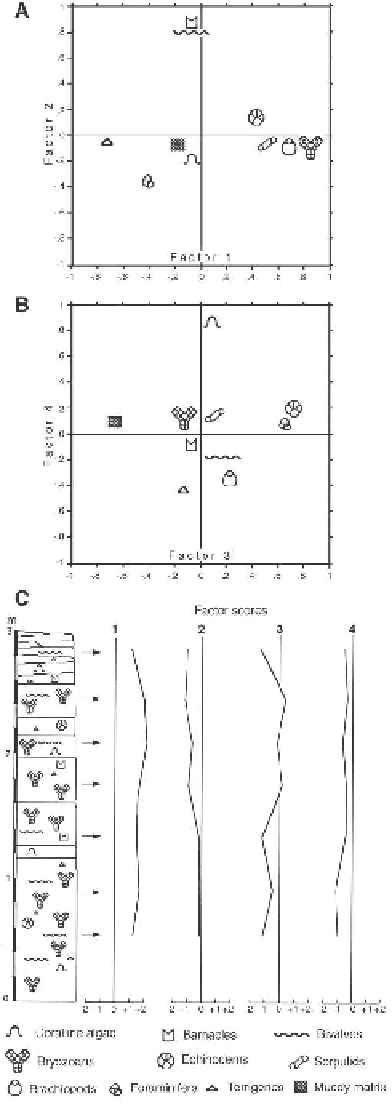Geology Reference
In-Depth Information
Fig. 6.13.
Factor analysis
reduces the overall complexity of
data by extracting factors which account for the variance ob-
served in the data and facilitates the evaluation of the causal
factors which control sediment composition. In this case study
from the Miocene Zogelsdorf Formation northwest of Vienna,
Austria, the R-mode principal component analysis of point
counts in 118 thin sections is used to deduce environmental
controls. The Zogelsdorf Formation represents carbonate de-
posits formed in a warm temperate environment (Pl. 93/7, Pl.
106/3). Factor loading of individual components are weighted
with respect to the contribution of that component to the fac-
tor. Factor scores estimate the contribution of the factors to
each original observation (the samples). In the case studies
four factors were found to be primarily responsible for the
distribution of skeletal grains, carbonate mud and terrigenous
grains. The interpretation of these factors is based on the re-
lationships of these components within the factors, the eco-
logical constraints of the calcareous organisms, the distribu-
tion of the components within the geological section, and the
comparison to modern environments.
A
- Factor loading of factor 1 vs. factor loading of factor 2.
Factor 1 explains 26% of the variance and shows a highly
positive loading of bryozoans, brachiopods and serpulids
along with a positive loading of echinoderms. A highly nega-
tive loading is shown by terrigenous components. Factor 2
explains nearly 17% of the variance and is characterized by a
very highly positive loading of barnacles and epifaunal bi-
valves, and a highly negative loading of foraminifers.
B
- Factor 3 vs. factor 4 plot. Factor 3 explains 14.3% of the
variance; echinoderms and foraminifers exhibit a highly posi-
tive loading, the muddy matrix a highly negative loading.
Factor 4 represents 10.4% of the variance; coralline algae are
highly positively loaded. Negative loading is shown by ter-
rigenous components.
Interpretation:
Primary controls responsible for the com-
ponent distribution were terrigenous input, hydrodynamic en-
ergy, presence of seagrass and light intensity. Factor 1 re-
flects the detrimental effect of high terrigenous input to fil-
ter-feeding bryozoans, brachiopods and serpulids. Factor 2
is seen to reflect the exposure to high energy water condi-
tions. The interpretation is supported by the dominance of
barnacles and epifaunal bivalves and the occurrence of this
facies in coastal settings. Factor 3 should explain the positive
loadings for echinoderms and foraminifers. The presence of
seagrass can be derived from the increased occurrence of regu-
lar echinoids and of epiphytic foraminifera. Factor 4 with a
highly positive loading for coralline red algae could reflect
light intensity related to water depth and suspension loads.
C
- Geological section and changes in factor scores during
time. Modified from Nebelsick (1992).
Purdy, E.G. (1963): Recent calcium carbonate facies of the
Great Bahama Bank. I. Petrography and reaction groups. -
J. Geol.,
73
, 334-355
Rasser, M.W. (2000): Coralline red algal limestones of the
late Eocene Alpine foreland basin in Upper Austria: com-
ponent analysis, facies and palaeoecology. - Facies,
42
,
59-92
Shi, G.R. (1993): Multivariate data analysis in palaeoecology
and palaeobiogeography - a review. - Palaeogeogr.,
Palaeoclimat., Palaeoecol.,
105
, 199-234
Swan, A.R.H., Sandland, M. (1995): Introduction to geologi-
cal data analysis. - 446 pp., Oxford (Oxford Press)
Toomey, D.F. (1966): Application of factor analysis to a fa-
cies study of the Leavenworth limestone (Pennsylvanian-
Virgilian) of Kansas and environs. - Special Distribution
Publication, Kansas Geological Survey,
27
, 1-28
Further reading
: K147

